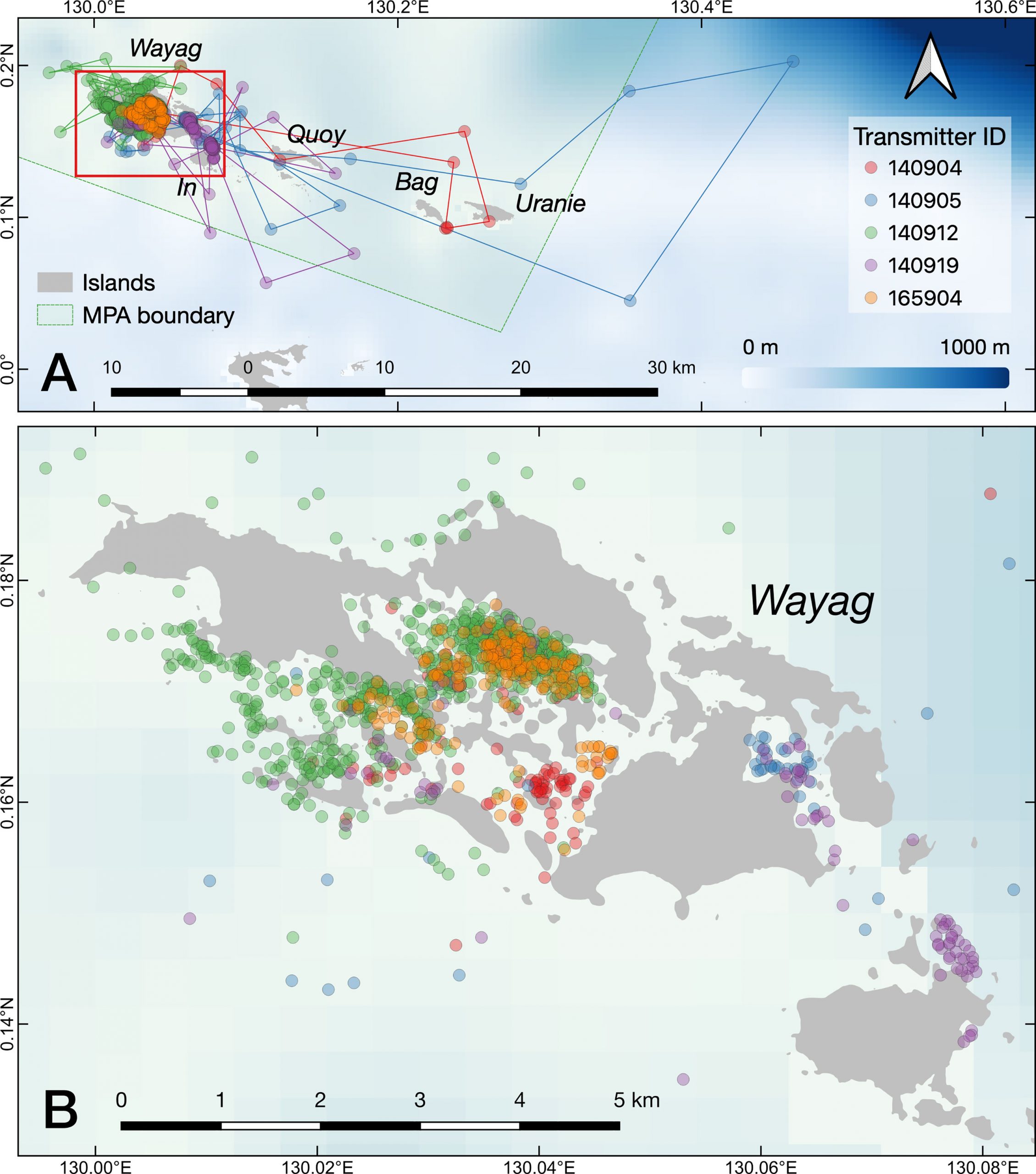← Back
A nursery for juvenile reef manta rays

Reef manta rays are a vulnerable species. They grow up in protected shallow areas such as lagoons. Tracking them with Argos can help to confirm that a given lagoon is a nursery for this species
Photo: a female juvenile reef manta ray sized 220 cm (wingspan; they are considered as adult at about 320 cm) with a pop-up archival tag on the right side of its dorsum and yellow pilot fish in front of its mouth (credit Edy Setyawan)
Reef manta rays (Mobula alfredi), as all the global populations of oceanic sharks and rays, have declined significantly over the last half century. They are found all around the tropical seas. In Indonesia, manta rays are considered as a conservation target. To support conservation efforts, identifying the species’ critical habitats is a priority.
A juvenile reef manta ray nursery?
As many elasmobranch species, reef manta rays are using shallow and sheltered waters like lagoons as nursery for newborns. Within those, the juvenile rays find calm seas, food, protection from predators and other reef manta rays for social interactions.
The Wayag lagoon, Raja Ampat, Indonesia is strongly suspected to be such a reef manta ray nursery site. A study showed that juveniles were especially present in the lagoon, and this year after year, two of the three criteria confirming a site as manta ray nursery. The last of the three criteria would be that the juvenile manta rays remain within the area for extended periods. Argos telemetry can help in that last check.
Argos-tracking of juvenile reef manta rays
Five juvenile reef manta rays (mostly females) were equipped with satellite archival pop-up tags in Wayag lagoon in 2015 and 2017. Whenever surfacing, those tags computed and transmitted GPS positions. Moreover, dive-depth, light levels, and ambient sea temperature were recorded. Nine other juveniles were tracked using passive acoustic transmitters from May 2019–September 2021. Moreover, a total of 34 juvenile manta rays were photo-identified between May 2013–May 2021. Nine of the 34 of them were resighted at least once within the Wayag lagoon, among which six recording sighting spans in excess of 320 days, including two that were resighted after 21 months. The remaining 25 were never resighted .
More info about animal tracking with Argos

Juvenile reef manta rays GPS tracks (lines) derived from locations (dots) (A) the SAP Waigeo Barat Marine Protected Area with names of the islands; (B) a close up of the Wayag lagoon (from [Setyawan et al., 2022])
Juvenile reef manta rays remained within the lagoon
The Argos-tracked individuals did not go far from Wayag lagoon. Three of the five never went further than 10 km, and the maximum movement was 47 km to the east of the lagoon. A space-state model was built to estimate locations at regular time intervals and to compute activity spaces.
The results suggest that all tagged manta rays spent most of their time within the lagoon, or in adjacent waters, going further only for short periods. They may have been developing their searching for prey in a more open ocean environment by such exploratory behaviours.
This juvenile behaviours of remaining within the lagoon is the last step to conclude that reef manta rays use Wayag lagoon as a nursery. It may also act as a pupping ground.

Core activity space and the extent of activity space for each of the five juvenile reef manta rays satellite tracked. The red polygons (50% UD) and the orange polygons (95% UD) denote the smallest estimated core activity space and the extent of activity space, respectively (from [Setyawan et al., 2022])
Redesign of the Marine Protected Areas
The management authorities of the Raja Ampat Marine Protected Areas were advised of these conclusions. They choose in particular to designate some areas within the main Wayag lagoon as “core conservation zones” with strictly restricted access and the whole lagoon area as “manta nursery zones”, in order to ensure its nursery function is not compromised.
Reference and links
- Setyawan E, Erdmann MV, Mambrasar R, Hasan AW, Sianipar AB, Constantine R, Stevenson BC and Jaine FRA (2022): Residency and Use of an Important Nursery Habitat, Raja Ampat’s Wayag Lagoon, by Juvenile Reef Manta Rays (Mobula alfredi). Front. Mar. Sci. 9:815094. https://doi.org/10.3389/fmars.2022.815094
- For the previous study: Setyawan, E., Erdmann, M. V., Lewis, S. A., Mambrasar, R., Hasan, A. W., Templeton, S., et al. (2020). Natural History of Manta Rays in the Bird’s Head Seascape, Indonesia, With an Analysis of the Demography and Spatial Ecology of Mobula alfredi (Elasmobranchii: Mobulidae). J. Ocean. Sci. Found. 36, 49–83. doi: 10.5281/zenodo.4396260 (https://birdsheadseascape.com/conservation-science/natural-history-of-manta-rays-in-the-birds-head-seascape-a-new-study-by-edy-setyawan-et-al/)
- A short video on the reef manta ray nursery in Wayag lagoon:
https://www.youtube.com/watch?v=Z3vtPQlR3DU
- A novel and non-invasive method to measure manta rays using drones in Raja Ampat:
https://birdsheadseascape.com/diving/measuring-mantas-how-and-why-a-novel-approach-by-edy-setyawan/
https://www.youtube.com/watch?v=x47Dapb3oXA
- Summary of manta ray conservation in Raja Ampat and Indonesia:
https://birdsheadseascape.com/conservation-science/a-ray-of-hope-for-the-future-of-elasmobranch-in-the-worlds-largest-manta-sanctuary-by-edy-setyawan/


